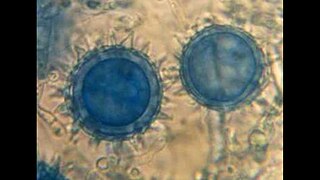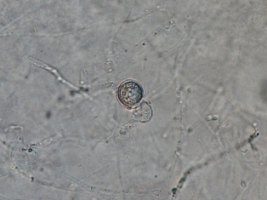
The Oomycetes, or Oomycota, form a distinct phylogenetic lineage of fungus-like eukaryotic microorganisms within the Stramenopiles. They are filamentous and heterotrophic, and can reproduce both sexually and asexually. Sexual reproduction of an oospore is the result of contact between hyphae of male antheridia and female oogonia; these spores can overwinter and are known as resting spores. Asexual reproduction involves the formation of chlamydospores and sporangia, producing motile zoospores. Oomycetes occupy both saprophytic and pathogenic lifestyles, and include some of the most notorious pathogens of plants, causing devastating diseases such as late blight of potato and sudden oak death. One oomycete, the mycoparasite Pythium oligandrum, is used for biocontrol, attacking plant pathogenic fungi. The oomycetes are also often referred to as water molds, although the water-preferring nature which led to that name is not true of most species, which are terrestrial pathogens.

Pythium oligandrum is an oomycete. It is a parasite of many fungi and other oomycetes including Botrytis, Fusarium and Phytophthora. It has been licensed as a biocontrol agent in the form of an oospore soil treatment, which reduces pathogen load and concomitant plant disease. P. oligandrum have been found to express several genes belonging to the CAZy-family when feeding on prey. P. oligandrum can grow within the roots of certain plants, including tomato and sugar beet. Production of auxin-like substances stimulate plant growth. Defense responses can be induced in the plant, which primes the plant from further infection by pathogenic fungi, oomycetes or bacteria.

Pythium is a genus of parasitic oomycetes. They were formerly classified as fungi. Most species are plant parasites, but Pythium insidiosum is an important pathogen of animals, causing pythiosis. The feet of the fungus gnat are frequently a vector for their transmission.

Metalaxyl is an acylalanine fungicide with systemic function. Its chemical name is methyl N-(methoxyacetyl)-N-(2,6-xylyl)-DL-alaninate. It can be used to control Pythium in a number of vegetable crops, and Phytophthora in peas. Metalaxyl-M is the ISO common name and Ridomil Gold is the trade name for the optically pure (-) / D / R active stereoisomer, which is also known as mefenoxam.

Pythiosis is a rare and deadly tropical disease caused by the oomycete Pythium insidiosum. Long regarded as being caused by a fungus, the causative agent was not discovered until 1987. It occurs most commonly in horses, dogs, and humans, with isolated cases in other large mammals. The disease is contracted after exposure to stagnant fresh water such as swamps, ponds, lakes, and rice paddies. P. insidiosum is different from other members of the genus in that human and horse hair, skin, and decaying animal and plant tissue are chemoattractants for its zoospores. Additionally, it is the only member in the genus known to infect mammals, while other members are pathogenic to plants and are responsible for some well-known plant diseases.

Pythiaceae is a family of oomycetes. The family includes serious plant and animal pathogens in the genus Pythium. The family was circumscribed by German mycologist Joseph Schröter in 1893.

Damping off is a horticultural disease or condition, caused by several different pathogens that kill or weaken seeds or seedlings before or after they germinate. It is most prevalent in wet and cool conditions.

Pythium debaryanum is a species of water mould in the family Pythiaceae. It is known as a plant pathogen on many kinds of wild and cultivated plants, including peanut, beet, eucalyptus, tobacco, and pine trees. The plants develop damping off, a disease state.
Pythium ultimum is a plant pathogen. It causes damping off and root rot diseases of hundreds of diverse plant hosts including corn, soybean, potato, wheat, fir, and many ornamental species. P. ultimum belongs to the peronosporalean lineage of oomycetes, along with other important plant pathogens such as Phytophthora spp. and many genera of downy mildews. P. ultimum is a frequent inhabitant of fields, freshwater ponds, and decomposing vegetation in most areas of the world. Contributing to the widespread distribution and persistence of P. ultimum is its ability to grow saprotrophically in soil and plant residue. This trait is also exhibited by most Pythium spp. but not by the related Phytophthora spp., which can only colonize living plant hosts.
Pythium aphanidermatum is a soil borne plant pathogen. Pythium is a genus in the class Oomycetes, which are also known as water molds. Oomycetes are not true fungi, as their cell walls are made of cellulose instead of chitin, they are diploid in their vegetative state, and they form coenocytic hyphae. Also, they reproduce asexually with motile biflagelette zoospores that require water to move towards and infect a host. Sexually, they reproduce with structures called antheridia, oogonia, and oospores.
Pythium dissotocum is a plant pathogen infecting strawberry and rice.

Pythium sulcatum is a chromalveolate plant pathogen infecting carrots. Because this organism was once thought to be a type of fungus, it is still often treated as such.
Achlya klebsiana is a plant pathogen. Studies say that this fungi potentially poses threats against fish in the Nile.
The laimosphere is the microbiologically enriched zone of soil that surrounds below-ground portions of plant stems; the laimosphere is analogous to the rhizosphere and spermosphere. The combining form laim- from laimos denotes a connecting organ (neck) while -sphere indicates a zone of influence. Topographically, the laimosphere includes the soil around any portion of subterranean plant organs other than roots where exuded nutrients stimulate microbial activities. Subterranean plant organs with a laimosphere include hypocotyls, epicotyls, stems, stolons, corms, bulbs, and leaves. Propagules of soil-borne plant pathogens, whose germination is stimulated by a plant exudates in the laimosphere, can initiate hypocotyl and stem rots leading to "damping-off". Pathogens commonly found to cause such diseases are species of Fusarium, Phoma, Phytophthora, Pythium, Rhizoctonia and Sclerotinia.
Aphelenchoides is a genus of mycetophagous nematodes. Some species are plant pathogenic foliar nematodes.

Pythium insidiosum is a species of Pythium and a member of the class oomycota. Pythium insidiosum is mainly found in standing water and occasionally soil. Unlike most Pythium species, which are generally pathogens of terrestrial plants, Pythium insidiosum is a pathogen of mammals. It causes pythiosis, mainly in horses, dogs, and humans. It can also cause disease in cats. It is a non-transmissible disease and occurs mainly in tropical climate, endemic to Thailand, affecting mainly humans and horses and in Brazil, affecting mainly horses. Infection can occur in healthy mammals. The pathogen is well-adapted to mammalian body temperature, with an optimum temperature for growth of 34–36 °C (93–97 °F).
Pythium emineosum is a plant pathogen, first isolated in Canada.
Pythium camurandrum is a plant pathogen, first isolated in Canada.
Globisporangium sylvaticum is a plant pathogen, an oomycete known to cause root rot and damping off in a multitude of species. These species include apples, carrot, cherry laurel, cress, cucumber, garlic, lettuce, pea, rhododendron, and spinach. Symptoms of infection include stunting, wilt, chlorosis, and browning and eventual necrosis of roots. The pathogen can by identified by the presence of thick, microscopic, round spores within the cells of the root.
Pythium porphyrae, is a parasitic species of oomycete in the family Pythiaceae. It is the cause of red rot disease or red wasting disease, also called akagusare (赤ぐされ) in Japanese. The specific epithet porphyrae (πορφυρα) stems from the genus of one of its common hosts, Porphyra, and the purple-red color of the lesions on the thallus of the host. However, many of its hosts have been moved from the genus Porphyra to Pyropia.







